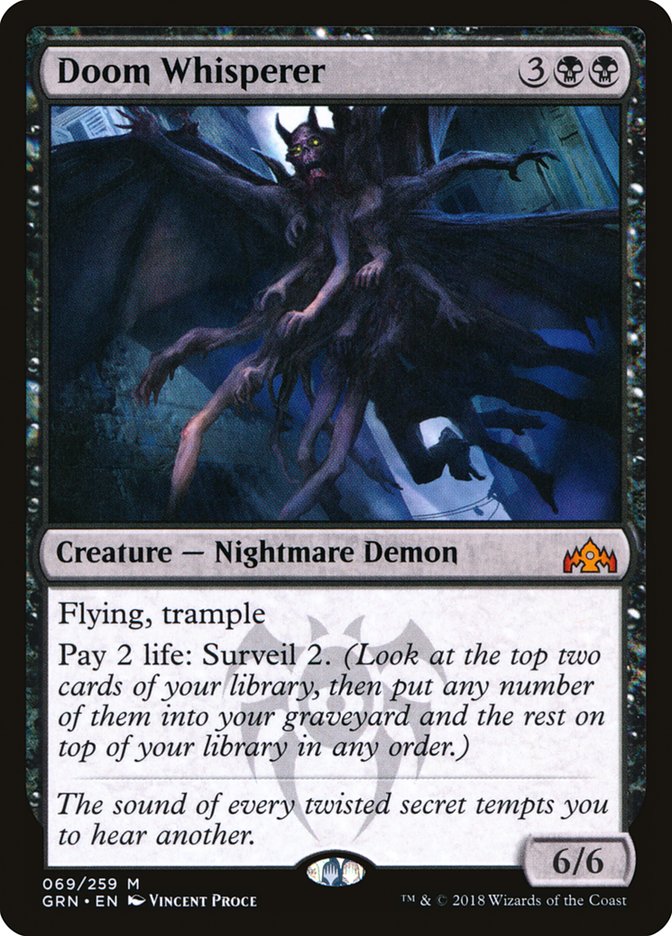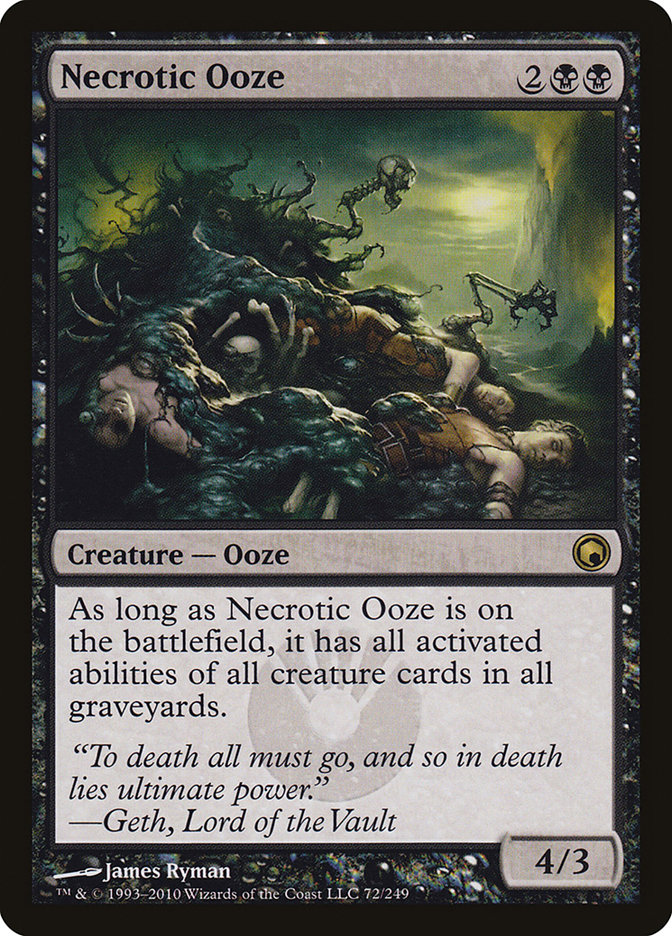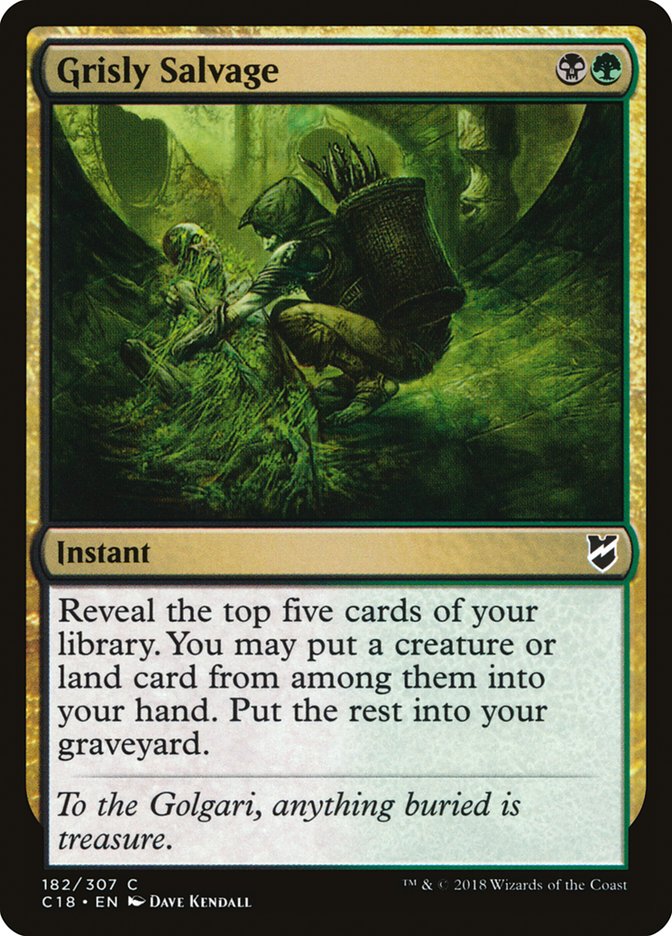One of the hallmarks of a good deckbuilder is the ability to build with
purpose. In interacting with aspiring players, I’ll get questions along the
lines of “I’m attempting to build a Sultai/Jeskai/Surveil/Teferi/etc. deck
post-Guilds of Ravnica, can you give me advice?” This is an
impossible question to answer in the absence of further information.
The key piece that is often left out is “Why?” Why have you decided that
this is the deck you should be spending your time on? What do you think
this deck can do better than everything else? What edge are you gaining?
This key piece of information is something I’ve come to think of as the
“strategic principle.” It is challenging to give a clean definition of the
term, but the closest I’ve gotten is:
the method by which I impose my will on my opponent and ultimately end
the game.
To put it another way, imagine you’re a deck salesperson, and your job is
to do a presentation designed to sell your deck to others. As part of this
presentation, you get to display a sample game of Magic, designed to show
off what your deck can do. Keep in mind, your audience is a group of
sophisticated Magic businesspeople. You’re not going to sell them with a
one-sided stomp or nut draw. You will have to show your deck taking your
opponents’ best shot and still managing to come out ahead. The tactics and
capabilities you would choose to display in this game are representative of
your deck’s strategic principle.
The strategic principle of your deck is an all-encompassing road map to
your deck’s success. It informs your card selections in deckbuilding. It
informs your sideboard plans. Indeed, it informs the very way you should be
choosing to play games of Magic with your weapon of choice. If every
decision you’ve made in the deckbuilding process has been in furtherance of
a single goal, in-game decisions can be reduced to their purest essence.
You simply ask, “What play brings me closest to my strategic principle?”
While this is overly simplistic, and flexibility is indispensable in Magic,
its always nice to have a starting point for your decision trees.
At first, I could see someone feeling limited by the requirement to impose
a strategic principle on every deck they’re building. “What if I just want
to build around a specific card,” you ask?
Building with a strategic principle in mind is one of the easiest ways to
make sure you’re maximizing whatever card it is that has inspired you. This
is exactly what I intend to do today, and there’s a Guilds of Ravnica card that is currently the apple of my eye.
Maybe its just the fact that I’ve been around Magic for 20+ years, but when
you tell me I’m getting a 6/6 flying, trampling Demon for five mana, my
response will likely be “How many creatures do I have to sacrifice?”
Instead, Doom Whisper comes with incredible upside stapled on-a non-mana
gated Vampiric Tutor proxy that also fills your graveyard along the way.
Are you kidding me?
I think Doom Whisperer is still being slept on to some extent. I’ve mostly
seen it included in small numbers, seemingly in acknowledgment of its
impressive rate but without any effort to maximize its capabilities.
Focusing on strategic principles will allow us to avoid this mistake and
turn Doom Whisperer into the format lynchpin it is destined to become.
It’s easy to identify a card as pushed when there’s diversity in the
strategic principles it encourages you to explore. Doom Whisperer merits
consideration in virtually every style of deck you can possibly build. Here
are some of my favorites.
Strategic Principle: The Snowball
Creatures (29)
- 4 Llanowar Elves
- 4 Druid of the Cowl
- 1 Thrashing Brontodon
- 3 Ravenous Chupacabra
- 4 Elvish Rejuvenator
- 4 Stitcher's Supplier
- 2 Izoni, Thousand-Eyed
- 4 Doom Whisperer
- 3 Glowspore Shaman
Planeswalkers (2)
Lands (23)
Spells (6)

Cribbing a style from one of my deckbuilding idols, Zvi Mowshowitz, I
picked up a host of cards designed to ensure I’m producing mana at an
accelerated rate and went all-in on the most impressive payoff I could
find. The principle we embrace here is that if your first Doom Whisperer
enters the battlefield early enough, it will always transition you to an
effective next play, regardless of your opponent’s ability to deal with it.
Many times, this will consist of another Doom Whisperer, but sometimes
Izoni, Thousand-Eyed and her army of Insects will be just what the Shaman
ordered. Izoni will lead to a protected Vraska, Golgari Queen, or maybe a
Find. Either way, the writing is likely on the wall for your opponent.
The card that really makes this deck possible is Ravenous Chupacabra. When
this card was released, I took a hardline stance against
the settler-of-controversies himself
Patrick Sullivan and declared Chupacabra to be massively overrated. It just
didn’t line up well against a format of threats like The Scarab God,
Torrential Gearhulk, and Rekindling Phoenix. While Chupacabra-mania
simmered down from its peak of “Four Chupacabra in everything!!!” people
continued to play the card in limited numbers throughout much of the
format, often to their detriment.
Fast forward to today and I now believe Ravenous Chupacabra to be one of
the best cards in the format, and I haven’t heard anyone say a word about
it. Thus far, I’m considering the following two decks as the baseline of
the format:
Creatures (20)
Planeswalkers (3)
Lands (8)
Spells (29)

Creatures (33)
- 4 Llanowar Elves
- 4 Merfolk Branchwalker
- 3 Deathgorge Scavenger
- 2 Ghalta, Primal Hunger
- 2 Jadelight Ranger
- 4 Steel Leaf Champion
- 4 Nullhide Ferox
- 2 Midnight Reaper
- 4 Glowspore Shaman
- 4 Pelt Collector
Planeswalkers (1)
Lands (22)
Spells (4)

I’ve been using these two impressive aggro decks as my litmus test for new
ideas. If a deck can’t keep base with the early efficient beaters contained
here, its not something I’m willing to consider at this juncture. These are
both decks with good old-fashioned creatures, the kind that do not enjoy
being eaten by a Chupacabra that will then stick around to block one of
their friends. Even the titular many-armed hero of this article is not
pleased to see Ravenous Chupacabra on the other side of the battlefield.
Times have changed. Adapt or get eaten by Chupacabra.
Strategic Principle: Protect the Queen
Creatures (3)
Planeswalkers (1)
Lands (26)
Spells (30)

The first time I ever saw a Doom Whisperer cast was on StarCityGames.com’s
own VS Live! series. Todd Anderson was playing Grixis Control against Brad
Nelson’s Sultai Midrange deck. If you’d like to see the brutality yourself,
you can watch here:
Once Todd untapped with Doom Whisperer, there was no realistic way he was
going to lose. This entire deck is designed to replicate those kinds of
moments by invoking a classic strategic principle-protecting the queen.
At its heart, the deck is a typical Dimir Control deck, packing all the
countermagic, removal, and Search for Azcantas you’d expect to see. The new
wrinkle comes in the form of Doom Whisperer, which finally offers Dimir an
unstoppable lategame that can keep pace with something like Teferi, Hero of
Dominaria.
If we get to the point in the game where we have a Doom Whisperer on the
battlefield with some open mana and a decent life total, our opponent
better hope they have a host of removal spells ready to go.
Consider what Doom Whisperer does for this archetype.
-
It offers a four-turn clock (often three-turn with shocklands
around). -
It will either provide a steady stream of tools to protect itself
or it will find you another Doom Whisperer. -
It puts your Chemisters’ Insights and Radical Ideas directly in the
graveyard, granting you more card drawing and filtering. -
It increases your outs to planeswalkers, an important strategic
point now that Torrential Gearhulk is gone and we have access to
fewer virtual copies of Vraska’s Contempt (no, Mission Briefing is
not playable).
Given these abilities, it should be clear why every card in this deck was
included for its ability to get us into a position where we can cast a Doom
Whisperer at a high life total and keep it on the battlefield.
Doom Whisperer is a game changer for Dimir Control, and there are so many
different roads this first iteration leads us to consider. Can we play a
more tap-out based version of control? Grixis? Esper? Mono-Black
Control??!?! These options seem reasonable when you have access to a tool
as powerful as Doom Whisperer. However, none of these archetypes will
execute the plan of protecting the queen as well as this type of Dimir
list. For this reason, it makes the most sense to start our exploration
here.
Strategic Principle: Maximizing the Mechanic
This next deck is inspired in no small part by this brilliant tweet from
Hall-of-Famer Willy Edel:
First draft of New T2 Surveil Jund. Can u get them
all?4 One mana Goyf
4 Narcomoeba
2
Lazav
2 Lifelink Scrapheap
3 JTMS
4
Griselbrand4 Contempt
2 Black Helix
2
Improved Fatal Push
3 Zero mana helix
3 Read the
Bones
3 No damage Seize3 Wasteland
8
Duals
7 Swamps
6 Islands— Willy
Edel (@bazardebagda) September
22, 2018
Those of you familiar with
my past work
are surely not surprised to see me drawn back to Narcomoebas. If I squint
just right, I think I start to see the deck through Willy’s eyes. I’m
basically powerless to resist some good hyperbole.
Our own Todd Anderson has also fallen in love with the archetype and will
be discussing it at length, so I will keep my submission on the deck brief.
The core of this deck is fairly obvious. In cases like this, maximizing a
mechanic involves identifying the indispensable core and shuffling the
moving parts around it to find the best possible configuration. Here’s my
shuffle.
Creatures (21)
- 4 Narcomoeba
- 4 Doom Whisperer
- 4 Thoughtbound Phantasm
- 3 Lazav, the Multifarious
- 2 Blood Operative
- 4 Dimir Spybug
Lands (23)
Spells (16)

Strategic Principle: Inevitability
Creatures (8)
Planeswalkers (2)
Lands (26)
Spells (24)

This is the deck that does the worst job using Doom Whisperer to further
its strategic principle. I’d argue this deck can be bifurcated cleanly.
Half of the cards are designed to allow you to reach your lategame. This
half is comprised of the removal and Gift of Paradises. The other half is
the unassailable lategame value engine of The Eldest Reborn and Golgari
Findbroker, along with some big spells in Pelakka Wurm; Vraska, Relic
Seeker; and Tetzimoc, Primal Death. I’d argue that Doom Whisperer (and to a
lesser extent, Arguel’s Blood Fast) floats somewhere between those
classifications. While this is the type of “on-rate inclusion” I questioned
in the introduction of the article, I want to see if Doom Whisperer can act
as the glue here as we transition from survival mode to unbeatable
card-advantage machine.
Even if this isn’t the best Doom Whisperer home, I still believe this deck
has a lot of potential. Ritual of Soot has proven to be perfectly
serviceable at answering the key threats of the format, and our lategame is
no joke. I wonder if I’m just supposed to be taking my own advice here and
playing Ravenous Chupacabra. It feels like it is much closer to our
strategic principle than Doom Whisperer and might be the first change this
deck demands.
It’s telling how the card that strays the furthest from our stated goals
makes the best candidate for the chopping block. While Doom Whisperer may
turn out to be a miss here, we already know that the card is on our
watchlist and why. Without this preemptive work, we might have played
dozens and dozens of games before we realized that Doom Whisperer wasn’t
carrying its weight. These efficiencies matter if you want to become a
top-tier deckbuilder, as there are always a plethora of ideas competing for
your time.
Bonus Modern Deck!
Strategic Principle: Redundancy
Creatures (29)
- 4 Birds of Paradise
- 4 Devoted Druid
- 1 Grim Poppet
- 1 Kitchen Finks
- 1 Morselhoarder
- 3 Noble Hierarch
- 1 Viscera Seer
- 1 Fauna Shaman
- 3 Necrotic Ooze
- 3 Duskwatch Recruiter
- 1 Walking Ballista
- 4 Vizier of Remedies
- 2 Doom Whisperer
Lands (21)
Spells (10)

I know it’s considered bad form to pat yourself on the back, but the amount
of discipline I showed by only including a small package of nonsense in
this deck really deserves to be applauded. Our strategic principle leads us
to maximize the number of paths that lead us to a game-winning combo.
Necrotic Ooze’s primary function here is serving as Devoted Druid five,
six, and seven, but I couldn’t resist taking advantage of Grim Poppet plus
Devoted Druid to turn Necrotic Ooze into a one-sided reusable Plague Wind.
Similarly, Devoted Druid and Morselhoarder in your graveyard is infinite
mana from a Necrotic Ooze, summoning sickness be damned. The one-of Kitchen
Finks and Viscera Seer are here to further diversify our paths to infinity.
It’s hard to overstate just how hard Doom Whisperer pushes Necrotic Ooze.
Every Ooze that is played at a healthy life total with a Doom Whisperer in
the graveyard now threatens to produce infinite mana at instant speed.
Worst case scenario, it can move you closer to your next chance to combo
off. This kind of versatility and redundancy is what changes a deck from a
gimmick to a format-definer. Not only is Doom Whisperer going to turn your
Necrotic Oozes up to eleven, but even in a format as lightning-fast as
Modern, a 6/6 flying trampler on turn 3 is nothing to scoff at.
Grisly Salvage is a beautiful new tool for this style of deck, as our
opponents will often slow down their own gameplan for fear of potentially
game-ending Chord of Callings. In those situations, end-of-opponent’s-turn
Grisly Salvage is a powerful play that tightens the noose around our
opponent’s neck without having to go all-in the way a Chord of Calling
might force us to.
It speaks volumes that Doom Whisperer is in the early lead for my week one
deck in both Standard and Modern. I know I’m not alone in my thinking, as
none other than The Innovator himself Patrick Chapin also has plenty of
homes (and an upcoming article!) for the big five-drop. Assassin’s Trophy
has rightly grabbed a lot of headlines as the next multi-format all-star,
but don’t be surprised if Doom Whisperer gets its hands on a lion’s share
of the trophies once Guilds of Ravnica is unleashed.
Conclusion
There’s a reason you’ve likely heard people rail against “good stuff” decks
in the past. These decks operate without a strategic principle to guide
them. It’s possible for these decks to rise to the top of a format, but
they usually only do so at times when the quality of the cards employed is
approaching problematic (e.g., Temur Energy).
By deckbuilding with a strategic principle in mind, you’re moving your
decks to a more advanced state and you will have an easier time identifying
candidates for inclusion and exclusion. I’ve found my greatest successes as
a deckbuilder early on in formats, and I’m confident that employing this
type of thinking is the reason why.




